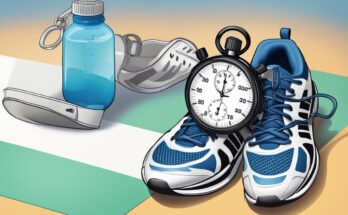Mastering running form is essential for both injury prevention and peak performance. Running with proper form can help runners avoid injuries and achieve their goals. However, many runners struggle with maintaining good running form, which can lead to poor performance and increased risk of injury.
To help runners master their running form, there are several essential tips to keep in mind. These tips include maintaining good posture, engaging the core, landing softly on the midfoot or forefoot, and swinging the arms in a relaxed and controlled manner. By implementing these tips, runners can improve their running form and reduce the risk of injury, while also achieving their desired level of performance.
In addition to these tips, it is important for runners to focus on their breathing, cadence, and stride length. By paying attention to these elements of running form, runners can further optimize their performance and reduce their risk of injury. With these essential tips in mind, runners can master their running form and achieve their goals with confidence and ease.
The Importance of Mastering Running Form
Mastering running form is essential for runners looking to prevent injuries and achieve peak performance. Good running form can help runners move more efficiently, reduce the risk of overuse injuries, and improve overall comfort while running. On the other hand, poor running form can lead to a host of problems, including increased risk of injury and decreased performance.
Benefits of Good Running Form
Good running form offers several benefits to runners. First and foremost, it can help runners move more efficiently, which can translate into faster times and longer distances. Proper running form can also help reduce the risk of overuse injuries, such as shin splints, plantar fasciitis, and IT band syndrome. Additionally, good running form can help runners feel more comfortable while running, reducing fatigue and making the experience more enjoyable.
Risks of Poor Running Form
Poor running form can lead to a host of problems for runners. One of the biggest risks of poor running form is an increased risk of injury. When runners don’t move efficiently, they put more stress on their joints, muscles, and bones, which can lead to overuse injuries. Poor running form can also lead to decreased performance, as runners waste energy on inefficient movements. Finally, poor running form can make running a less enjoyable experience, as runners may experience discomfort or pain while running.
In summary, mastering running form is essential for runners looking to prevent injuries and achieve peak performance. Good running form can help runners move more efficiently, reduce the risk of overuse injuries, and improve overall comfort while running. On the other hand, poor running form can lead to a host of problems, including increased risk of injury and decreased performance.
Essential Elements of Proper Running Form
Proper running form is essential for injury prevention and peak performance. The following sub-sections discuss the essential elements of proper running form, including posture, foot strike, arm swing, and hip position.
Posture
Good posture is essential for proper running form. Maintaining an upright posture helps to align the body, reducing the risk of injury and improving performance. When running, the shoulders should be relaxed, and the head should be held high, looking straight ahead. The chest should be open, and the back should be straight, with the core engaged.
Foot Strike
Foot strike refers to the way the foot hits the ground when running. The ideal foot strike is a midfoot strike, where the foot lands on the middle of the foot, rather than the heel or the toe. This helps to reduce the impact on the joints, improving performance and reducing the risk of injury. When running, the foot should land under the body, rather than in front of it.
Arm Swing
Arm swing is an essential element of proper running form. The arms should be relaxed, with the elbows bent at a 90-degree angle. The arms should swing back and forth, in a straight line, with the hands brushing the hips. The arm swing helps to maintain balance and rhythm when running.
Hip Position
Hip position is another important element of proper running form. The hips should be level, with the pelvis tilted slightly forward. This helps to engage the core muscles, improving stability and reducing the risk of injury. When running, the hips should be aligned with the feet, rather than swaying from side to side.
In conclusion, proper running form is essential for injury prevention and peak performance. Maintaining good posture, a midfoot strike, a relaxed arm swing, and proper hip position can help to improve performance and reduce the risk of injury.
Common Running Form Mistakes
Proper running form is essential for injury prevention and peak performance. Unfortunately, many runners make common mistakes that can lead to injury and reduced performance. Here are some of the most common running form mistakes and how to avoid them.
Overstriding
Overstriding is when a runner’s foot lands too far in front of their body. This can cause a braking effect, which slows the runner down and puts extra stress on their joints. Overstriding is a common mistake among new runners and those who are trying to increase their speed.
To avoid overstriding, runners should focus on increasing their cadence, or the number of steps they take per minute. A cadence of 180 steps per minute is often recommended. Runners can also try shortening their stride length and landing with their foot closer to their body.
Improper Foot Strike
The way a runner’s foot strikes the ground can also affect their performance and risk of injury. Heel striking, or landing on the heel of the foot, is a common mistake that can cause shock and stress on the joints. This can lead to injuries such as shin splints and knee pain.
To avoid heel striking, runners should focus on landing with a midfoot or forefoot strike. This means landing on the middle or front of the foot, rather than the heel. Runners can also try running barefoot or in minimalist shoes, which can help promote a natural foot strike.
Incorrect Posture
Poor posture can also affect a runner’s form and performance. Slouching or hunching over can cause the runner to lose energy and reduce their lung capacity. This can lead to fatigue and reduced performance.
To improve posture, runners should focus on keeping their shoulders back and down, their chest open, and their head up. They should also engage their core muscles to help support their spine and maintain proper alignment.
By avoiding these common running form mistakes, runners can improve their performance and reduce their risk of injury. It’s important to focus on proper form and technique to achieve the best results.
Injury Prevention Through Proper Running Form
Proper running form is essential for injury prevention and peak performance. By improving running form, runners can reduce the impact on their joints, improve stability, and avoid overuse injuries. In this section, we will discuss how runners can prevent injuries by focusing on proper running form.
Reducing Impact
The impact of running can cause stress on the joints, leading to injuries such as shin splints, stress fractures, and knee pain. Proper running form can help reduce the impact on the joints, preventing injury.
Here are some tips for reducing impact:
- Land softly: Try to land on the midfoot or forefoot instead of the heel.
- Shorten stride length: Taking shorter strides can reduce the impact on the joints.
- Increase cadence: A higher cadence can reduce the impact on the joints by decreasing the time that the foot is on the ground.
Improving Stability
Proper running form can also improve stability, reducing the risk of ankle sprains and other injuries. By improving stability, runners can maintain proper alignment and reduce the risk of falls.
Here are some tips for improving stability:
- Engage core muscles: Engaging the core muscles can help maintain proper alignment and improve stability.
- Keep shoulders relaxed: Tension in the shoulders can affect the alignment of the upper body, leading to instability.
- Look ahead: Looking ahead can help maintain proper alignment and improve balance.
Avoiding Overuse
Overuse injuries are a common problem for runners, caused by repetitive stress on the same muscles and joints. Proper running form can help prevent overuse injuries by distributing the workload more evenly across the body.
Here are some tips for avoiding overuse:
- Vary terrain: Running on different surfaces can distribute the workload more evenly across the body.
- Cross-train: Cross-training can help strengthen muscles that are not used as much during running, reducing the risk of overuse injuries.
- Listen to your body: If you feel pain or discomfort, take a break and allow your body to recover.
In conclusion, proper running form is essential for injury prevention and peak performance. By reducing impact, improving stability, and avoiding overuse, runners can prevent injuries and enjoy a safe and effective running experience.
Optimizing Running Performance
To become a better runner, it’s essential to focus on optimizing your running performance. Here are some tips to help you increase your speed, enhance your efficiency, and boost your endurance.
Increasing Speed
Improving your running speed requires consistent training and dedication. Here are some strategies to help you increase your speed:
- Incorporate interval training into your workouts. This involves running at a high intensity for a short period, followed by a period of rest or low-intensity running. Interval training can help you improve your speed and endurance.
- Work on your form. Proper running form can help you run more efficiently, which can lead to faster running times.
- Increase your mileage gradually. As your body adapts to running longer distances, you’ll become a more efficient runner, which can help you run faster.
Enhancing Efficiency
Efficiency is crucial for running performance. Here are some ways to enhance your running efficiency:
- Focus on your breathing. Proper breathing techniques can help you run more efficiently and reduce fatigue.
- Strengthen your core muscles. A strong core can help you maintain proper posture and reduce the risk of injury.
- Choose the right shoes. Wearing shoes that fit well and provide adequate support can help you run more efficiently.
Boosting Endurance
To run longer distances, you need to build endurance. Here are some strategies to help you boost your endurance:
- Incorporate long runs into your training. Gradually increase your mileage each week to build your endurance.
- Cross-train with low-impact activities like cycling or swimming to give your body a break from running while still building endurance.
- Fuel your body with proper nutrition. Eating a balanced diet can help you maintain energy levels during long runs.
By focusing on these tips, you can optimize your running performance and become a better runner.
Exercises for Improving Running Form
Proper running form is essential for injury prevention and peak performance. In addition to practicing good posture and engaging core muscles while running, incorporating exercises to improve running form can be beneficial. Here are some exercises that runners can do to improve their form:
Strength Training
Strength training is an essential component of improving running form. It helps to build strong muscles that can support the body while running. Here are some strength training exercises that can be incorporated into a runner’s workout routine:
- Squats: This exercise targets the glutes, quads, and hamstrings, which are essential for running. It helps to build strength in the lower body and improves balance and stability.
- Lunges: Lunges target the same muscles as squats but also help to improve hip flexibility and balance.
- Deadlifts: Deadlifts target the hamstrings, glutes, and lower back muscles, which are essential for running form. It helps to improve posture and reduce the risk of injury.
Flexibility and Mobility Exercises
Flexibility and mobility are also important for improving running form. They help to improve range of motion and reduce the risk of injury. Here are some exercises that can be incorporated into a runner’s workout routine:
- Hip Flexor Stretch: This stretch targets the hip flexor muscles, which can become tight from sitting for long periods. Tight hip flexors can lead to poor running form and increase the risk of injury.
- IT Band Foam Rolling: The IT band is a thick band of tissue that runs from the hip to the knee. Foam rolling can help to release tension in the IT band and improve mobility.
- Calf Stretch: This stretch targets the calf muscles, which are essential for running. Tight calf muscles can lead to poor running form and increase the risk of injury.
Running Drills
Running drills can help to improve running form by targeting specific muscles and movements. Here are some running drills that can be incorporated into a runner’s workout routine:
- High Knees: This drill targets the hip flexors and helps to improve knee lift and running form.
- Butt Kicks: Butt kicks target the hamstrings and help to improve leg turnover and running form.
- Skipping: Skipping helps to improve coordination and balance, which are essential for good running form.
Incorporating these exercises into a runner’s workout routine can help to improve running form, reduce the risk of injury, and improve overall performance.
Maintaining Good Running Form
To prevent injuries and achieve peak performance, maintaining good running form is essential. Here are some tips to help you maintain good form while running:
Regular Practice
One of the best ways to maintain good running form is through regular practice. The more you run, the more your body will get used to the movements and the easier it will be to maintain proper form. Running regularly also helps to build strength and endurance, which are important for maintaining good form.
Staying Mindful of Body Mechanics
Staying mindful of your body mechanics while running is another important factor in maintaining good form. This means paying attention to your posture, foot strike, and arm swing, among other things. For example, keeping your shoulders relaxed and your arms swinging naturally at your sides can help you maintain good form and prevent unnecessary tension in your upper body.
Consistent Warm-Ups
Consistent warm-ups are also important for maintaining good running form. A proper warm-up can help to increase your range of motion, improve your flexibility, and prepare your muscles and joints for the work ahead. This can help you maintain good form and prevent injuries.
Overall, maintaining good running form is essential for injury prevention and peak performance. Regular practice, staying mindful of body mechanics, and consistent warm-ups can all help to ensure that you maintain good form while running. By following these tips, you can help to improve your running form and achieve your goals.
Conclusion
In conclusion, mastering running form is crucial for injury prevention and peak performance. By following the essential tips outlined in this article, runners can improve their running efficiency and reduce the risk of injury.
One of the most important aspects of proper running form is maintaining good posture. This includes drawing the shoulders back, keeping the chest lifted, and engaging the core. Runners should also focus on their foot strike, aiming to land midfoot or forefoot rather than on the heel.
Additionally, runners should pay attention to their arm swing and cadence. Keeping the arms at a 90-degree angle and swinging them back and forth in line with the body can help improve running efficiency. Aiming for a cadence of around 180 steps per minute can also help reduce the risk of injury.
It’s important to remember that everyone’s running form will look slightly different, but the key is to find a form that works for your body and helps you run efficiently and safely. By incorporating these essential tips into their running routine, runners can improve their form, reduce the risk of injury, and achieve their peak performance.




